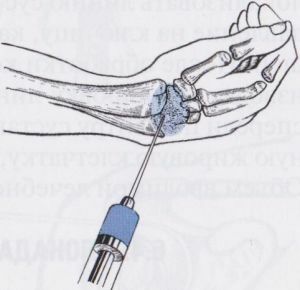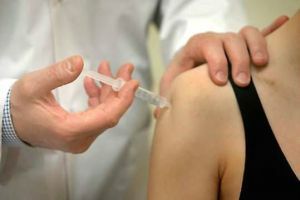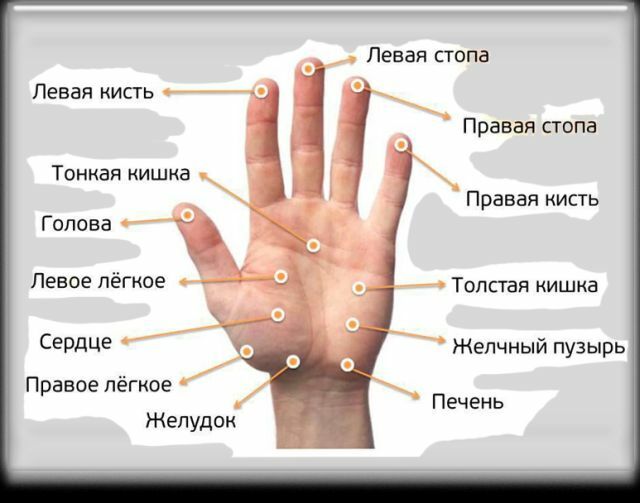 Under the definition of a therapeutic joint block is implied the introduction of one or more drugs into the cavity of the joint bag with the aim of arresting the pain syndrome and inflammatory changes.
Under the definition of a therapeutic joint block is implied the introduction of one or more drugs into the cavity of the joint bag with the aim of arresting the pain syndrome and inflammatory changes.
It is used for disorders of the musculoskeletal system. Also, the injection can be injected into nearby soft tissue.
This method is quite young in comparison with surgical, medicamentous, impact on affected joints with the help of acupuncture, stretching, massage and other methods.
This injection can completely eliminate the pain syndrome.
In cases where a neglected process takes place, such a method is part of a comprehensive treatment of the disease.
Contents of the article
- When are therapeutic blockades effective?
- What is the therapeutic blockade?
- Mechanism of exposure
- In what joints are the injections made?
- Points of influence
- What medicines are used?
- Knee block:
- features Intra-articular injection in the shoulder
- Injections into the hip joint
- Possible complications
When are effective blockades?
Therapeutic joint blockade is used in many pathologies. In particular, it is:
- intercostal neuralgia;
- pinched nerve endings, or tunnel syndrome;
- osteochondrosis of any part of the spine;
- bursitis;
- protrusion, herniated intervertebral joints( discs);
- tendon ganglion;
- heel spurs;
- rheumatoid arthritis;
- presence of contractures, pain in the joints or spine, caused by the trauma;

- deforming arthrosis;
- muscle spasms, accompanied by pain( musculotonic syndrome);
- is neuritis;
- gouty arthritis;
- hygroma;
- pathology of tissues surrounding the joints: ulnar epicondylosis, humeroscapular periarthrosis, etc.;
- Dupuytren's contracture.
What does the therapeutic blockade do?
After the administration of medications in the joint, pain is significantly reduced.
There is also a decrease in muscle spasm, edema, signs of inflammation disappear. In addition, in the joint, metabolic processes are normalized, their mobility increases.
This effect of manipulation is due to several factors:
- the maximum concentration of the drug at the site of the lesion;
- effect on the nervous system at the reflex level;
- action of anesthetic and medications.
Mechanism of exposure
An anesthetic penetrates to the nerve fibers and settles on their surfaces.
This is due to the relationship of the drug with phosphoproteins and phospholipids. As a result, a "struggle" develops between the anesthetic molecules and calcium ions, which slows down the exchange of sodium and potassium.
The strength of the effect of an anesthetic drug on neural structures is due to the type of conductor, as well as its pharmacological features.
 After an injection in the joint, a blockade of moth-free fibers - vegetative and painful conductors, responsible for slow conduction of nerve impulses.
After an injection in the joint, a blockade of moth-free fibers - vegetative and painful conductors, responsible for slow conduction of nerve impulses.
The effect is then on myelin fibers, providing epicritic pain. And only in the last instance are the motor fibers exposed.
The effectiveness of the manipulation depends on the following factors:
- The correct selection of the concentration of anesthetic preparation to ensure the blockade of certain nerve fibers.
- Accuracy of the administration of the anesthetic next to the receptor or conductor. The closer the injection is made, the less likely the development of complications.
In which joints are the injections made?
Medication blockade can be used to treat the pain of any joint.
The most common blockade of the knee, hip, elbow, shoulder joint, intervertebral articulations.
Also, manipulation can be used to block nerve endings or muscles.
Points of exposure
Injection can be carried out at one point where the pain is most pronounced, but in some cases the drugs are injected into several areas. What method of administration should be done in a particular case is decided by the doctor depending on the patient's condition.
Depending on the site of the injection, the joint block can be:
- Paravertebral - an injection is carried out near the vertebrae.
- Periarticular - drugs are injected into tissues located near the joint: tendons, ligaments, muscles.
- Intraarticular ( joint puncture) - medications are injected directly into the joint cavity.
- Intraosseous - injection is carried out in bone tissue.
- Epidural - the injection is made into the epidural cavity. This type of treatment blockade is carried out exclusively in a hospital.
What medicines are used?
It is compulsory for this manipulation to use:
- Local anesthetic preparations .These include Citanest, Lidocaine, Mesocaine, Carbocaine, and others. They are used to temporarily block the conductivity of impulses. Each drug has its own pharmacological properties, so when selecting a specialist, it takes into account the strength and speed of action, the duration of the period of penetration into nerve fibers, toxicity,
 inactivation methods, and elimination routes.
inactivation methods, and elimination routes. - To have a curative effect, use glucocorticosteroids .These drugs have a strong anti-shock, antitoxic, anti-inflammatory, anti-allergic, immunosuppressive, desensitizing effect. They are also able to prevent severe complications after manipulation.
- Group B vitamins have a small analgesic effect. They also accelerate the process of regeneration, the exchange of fats and carbohydrates, and enhance the action of anesthetic drugs. It is worth noting that the vitamins of this group can not be administered in a single syringe.
- preparations that promote the expansion of vessels can also be used. As a rule, it is no-spa or papaverine. The purpose of the application: increased therapeutic effect.
- If the therapeutic blockade is performed as an intraarticular injection with arthrosis of the knee joint, chondroprotectors are used. They serve as a lubricant, which improves mobility and reduces pain.
- In addition to the above drugs, the doctor can prescribe antihistamines and homeopathic remedies .
Knee block: features
Medication blockade of the knee joint is performed with injuries accompanied by pain syndromes.
As a rule, drugs are administered periarticularly or directly into the joint cavity. Depending on the severity of the pathological process, treatment is carried out from the inside and outside.
After manipulation, there is a significant reduction in pain sensations or none at all.
Their mobility also increases due to the formation of a protective film on cartilages. After the procedure, the joint is not subjected to friction and overload.
Intra-articular injections in the shoulder
Often the pain in the shoulder region is due to muscle rupture. This symptom worries not only with the load, but also in a state of complete rest.
 When you try to move, the discomfort increases. In such situations, the doctor recommends the introduction of hormonal drugs. Often a hormonal drug such as Diprospan is used for blockade of the shoulder joint.
When you try to move, the discomfort increases. In such situations, the doctor recommends the introduction of hormonal drugs. Often a hormonal drug such as Diprospan is used for blockade of the shoulder joint.
Thanks to its pharmacological properties, it starts to work just a few hours after the introduction and this effect lasts up to 21 days.
Also the advantage of the product is that it is absolutely painless, so it does not require the use of local anesthetics. In addition, Diprospan does not give complications after the manipulation.
Injections into the hip joint
Medical hip joint blockade should be performed by an experienced specialist and always under the supervision of ultrasound, as it is necessary to ensure the exact hit of the needle into the cavity.
In addition, manipulation requires the availability of special equipment. This procedure is effective in coxarthrosis of the hip joint.
Possible complications of
The probability of complications during medical blockade is very small, less than 0.5% of all cases. The risk of unpleasant consequences depends on the patient's condition, the quality of the procedure and its type.
Possible development of such complications:
- Toxic .Occur as a result of getting drugs in the lumen of the vessels, with the wrong selection of the drug, its concentration or dose. Also a similar problem can develop with insufficient skills of the health worker.
- Allergic reaction to preparation. It can proceed in a delayed type and in the form of anaphylactic shock. The first variant is characterized by cutaneous manifestations. With the development of shock, the patient's condition deteriorates sharply, respiratory failure, edema, and sometimes cardiac arrest.

- Vegetable-vascular .Are characterized by differences in blood pressure. The central nervous system does not suffer, and there are no changes in the respiratory system and heart.
- Puncture of the cavities of the ( abdominal, pleural, spinal,
- )
- Inflammatory , develops when infection is inflicted, the most severe consequences are periostitis, osteomyelitis, meningitis
- Traumatic , bruising, vascular and nerve damage
- Local reactions. Developed with an incorrectly selected preparation or a low-quality introduction. It is manifested in the form of edema, nonspecific inflammation, pain intensification.
Therapeutic blockade is an effective method, helpingto get rid of many pathologies of the musculoskeletal system. While it gives a minimum of complications, it can therefore be widely used in medical practice.



